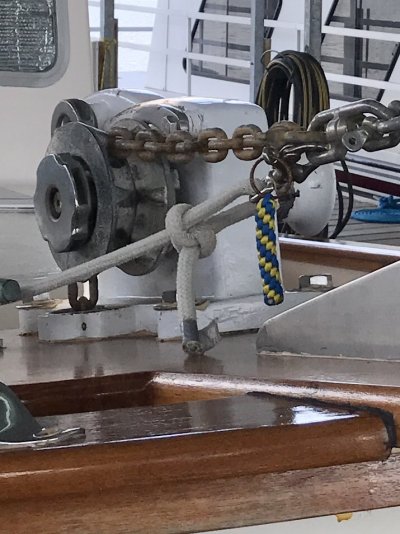JayN,
That sounds about right. Years of experience would help w the timing of it all. I assume you have a reel winch like most of the fishboats and probably hydraulic power. And your anchor is of such a design that the rode dosn’t snag it on the reversal.
Sorry, don't have a pic available, but yes, 300' of SS 1/4" cable with 40' 5/16" HT on a drum, 12VDC powered (up only). Having years of experience with laying out rode with a Danforth where it was easy to foul on the way down, most of the time the anchor (Rocna) gets to the bottom first and the rode lays out nicely in the clear.
If I was to do that the propwalk would pull my stern over and the bow would quickly catch up to the stern and I’d be broadside to the anchor.
I see your point on having a boat with significant prop walk. WESTERLY has very little prop walk. However, when deploying the anchor/rode during times of high winds, it can be very difficult to keep the boat from turning sideways. In these cases, I just let the boat fall off until the rode is deployed and the bow is turned into the wind, then set the anchor. Takes a little longer.
Interesting about going into reverse w fwd way on and waiting to stop and then moving aft. You must have the timing down well to have much control over nailing the position of your drop spot. Stuff happends so you must have some OMG stories. Care to share?
Going pretty slow up to the desired spot, just kicking ahead every now and then. So, not much headway on, often the headway is stopped by the time I get to the winch. When stemming a strong current, no engine reverse is necessary.
Can't recall any juicy stories about times when things didn't go right, but occasionally I think about being on the bow with the engine still in reverse, and I get a severe leg muscle cramp and unable to get back to the pilothouse in a timely manner. If the situation allows, sometimes, I just get sternway on the boat and put the engine in neutral before going to the bow. Just need to make an positioning adjustment relative to the desired spot.
As others have posted in this thread, being at the bow and watching/feeling the rode deploy and the anchor set provides tremendous feedback on bottom conditions and the quality of the set.

